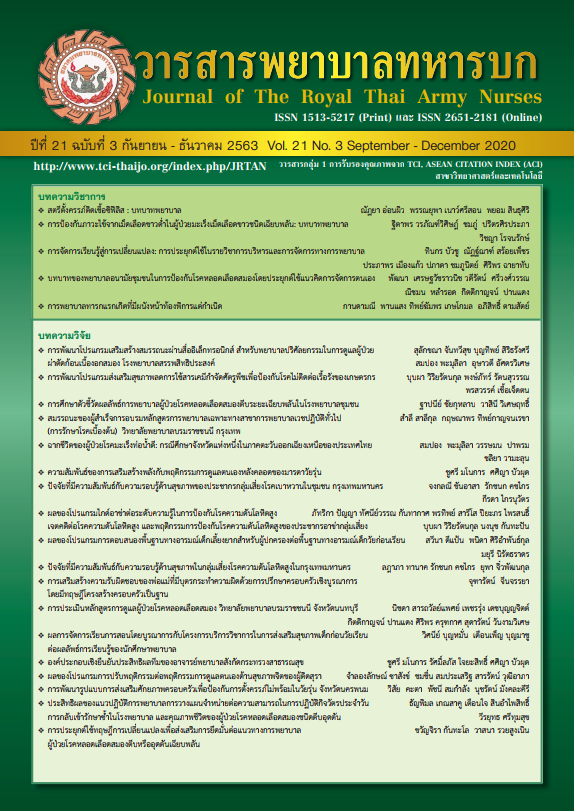Applying of Critical Autoethnography to Aesthetic of Self-Care by People with Epilepsy
Keywords:
Critical Autoethnography, People with Epilepsy, Aesthetics of Self CareAbstract
This research article aims to disclose the process of knowledge construction from the experiences of people with epilepsy through self-observation and reflection, leading to the redefinition of the identities of the participants in this research. The emphasis on self-reflection is a core interest of autoethnography. The researcher shared her view critically with other participants in this sub-culture to create a better understanding among the public of their lives and how they negotiate local health culture. Another objective is to present an example of how critical autoethnography as a social research methodology can be applicable for research in the field of nursing. To elaborate, part of a doctoral dissertation entitled ‘Aesthetic Knowledge Construction by People with Epilepsy’, was selected to demonstrate this application in order to offer new ideas and to indicate the potential of autoethnography in nursing research, and to provide other ways to genuinely understand patients and the experiences of family members. The results revealed that the desires of people with epilepsy, and their various pathways through dialectical self-reflection on self-reliance in the health culture context and the Thai social context. Their desires were as follows: (1) to control their seizures; (2) to perform the independent activities of daily living; (3) to earn income for themselves and their families; (4) to be able to take care of their family members; and (5) to live happily and with dignity with epilepsy in the eyes of the public. Therefore, the meaning of the aesthetics in caring for themselves differed depending upon their own conditions, self-reflection, and the context of their desires and their livelihood.
Downloads
References
Kata P and Chawraingern S. Culture epidemiology. Nonthaburi: D-One Company; 2018. (in Thai).
Denzin NK and Lincoln YS. Handbook of qualitative research. (4th ed.) California: Sage; 2011.
Talchue R and Jitpanya C. Factors related to depression in patients with epilepsy: a systematic review. Princess of Naradhiwas University Journal. 2012; 4(3): 1-13. (in Thai).
Wiriya K. Phenomenology in nursing: Qualitative research based on Gadamer’s Philosophy. Thai Journal of Nursing. 2015; 64(3): 6-13. (in Thai).
Klunklin A and Uppor W. Grounded theory study in nursing research. Nursing Journal. 2019; 46: 116-127. (in Thai).
Sripa K. Hermeneutic phenomenology research in nursing. Journal of The Police Nurse. 2012; 4(2): 1-18. (in Thai).
Khungtumneam K. Ethnography research for nursing service system in ASEAN. Journal of The Royal Thai Army Nurses. 2014; 15(1): 29-35. (in Thai).
Creswell JW and Poth CN. Qualitative inquiry and research design: choosing among five approaches. (4th ed.) Thousand Oaks, California: Sage; 2017.
Ellis C, Adams TE and Bochner AP. Autoethnography: an overview. Historical Social Research. 2011; 36(4): 273-290.
Boylorn RM and Orbe MP. Critical autoethnography: intersecting cultural identities in everyday life. California: Left Coast Press; 2014.
Pace S. Writing the self into research: using grounded theory analytic strategies in autoethnography. In N McLoughlin and DL Brien (Eds.), Creativity: cognitive, social and cultural perspectives. New York: Red Factory; 2012.
Richards R. Saying the word: voice and silence in an autoethnography about chronic illness. Linguistics Plus. 2016; 49: 233-247.
Shankar S. An autoethnography about recovering awareness following brain injury: is my truth valid? Qualitative Inquiry. 2018; 24(1): 56-69.
Scarfe SV and Marlow C. Overcoming the fear: an autoethnographic narrative of running with epilepsy. Qualitative Research in Sport, Exercise and Health. 2015; 7(5): 688-697.
Alcock J. An autoethnography of parenting a daughter whose complex disability was diagnosed in her adulthood. Autism Open Access. 2016; 6(6): e1000193.
Tilley-LubbsGA. Critical autoethnography and the vulnerable self as researcher. In GA Tilley-Lubbs and SB Calva (Eds.), Re-telling our stories. Boston: Sense Publisher; 2016.
Struthers J. Analytic autoethnography: a tool to inform the lecturer’s use of self when Teaching mental health nursing? [thesis]. Lancaster: Lancaster University; 2012.
Ramalho-de-Oliveira D. Qualitative research in pharmacy education: overview and prospect of autoethnography in pharmacy education and practice. American Journal of Pharmaceutical Education. 2020; 84(1) 156-165.
World Health Organization. Epilepsy: a public health imperative. Summary. Geneva: World Health Organization; 2019.
Mbuba CK and Newton CR. Packages of care for epilepsy in low-and middle-income countries. PLoS Med. 2009; 6(10): e1000162.
Havanon N. Narrative approach: the turning point of social science research. Journal of Mekong Societies. 2009; 5(2): 1-22. (in Thai).
Schirato T, Danaher G and Webb J. Understanding Foucault: a critical introduction. (2nded.) California: Sage; 2012.
Downloads
Published
How to Cite
Issue
Section
License
บทความหรือข้อคิดเห็นใดใดที่ปรากฏในวารสารพยาบาลทหารบกเป็นวรรณกรรมของผู้เขียน ซึ่งบรรณาธิการหรือสมาคมพยาบาลทหารบก ไม่จำเป็นต้องเห็นด้วย
บทความที่ได้รับการตีพิมพ์เป็นลิขสิทธิ์ของวารสารพยาบาลทหารบก
The ideas and opinions expressed in the Journal of The Royal Thai Army Nurses are those of the authors and not necessarily those
of the editor or Royal Thai Army Nurses Association.






